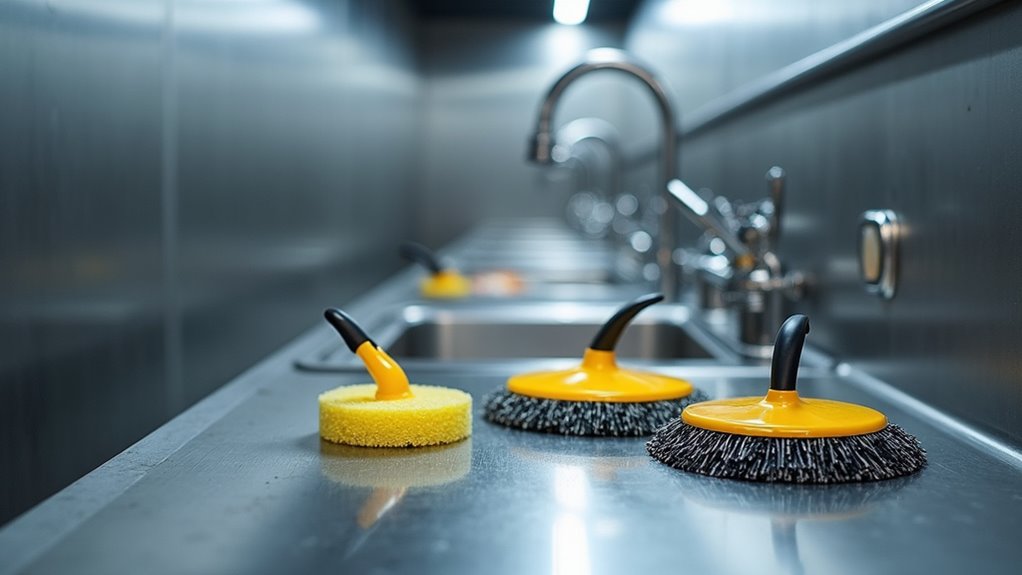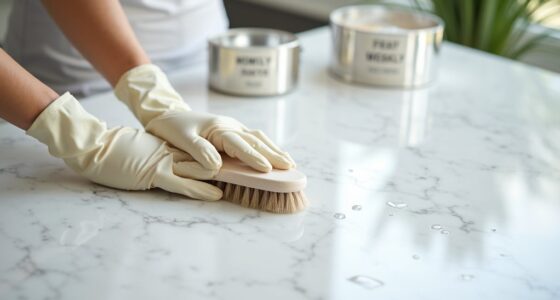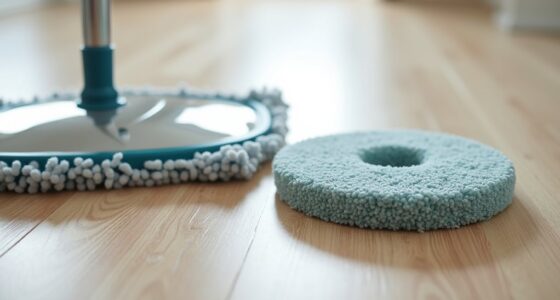To keep your restaurant scrubbers in top shape, you should rinse and sanitize them daily to prevent bacteria buildup, inspect for wear, and adjust water and solution levels. Weekly, disassemble and clean all parts thoroughly, replace worn components, and calibrate settings. Perform monthly inspections of motors and seals, lubricate moving parts, and update maintenance records. Staying consistent with these steps helps ensure hygiene, efficiency, and longevity—keep going to discover all essential tips for each maintenance stage.
Key Takeaways
- Rinse and sanitize scrubber heads and handles daily to prevent bacterial buildup.
- Disassemble and thoroughly clean all parts weekly to remove grease and residue.
- Inspect and replace damaged components monthly to ensure optimal performance.
- Regularly check water levels and solution concentrations to maintain cleaning effectiveness.
- Maintain detailed records of maintenance activities to track issues and ensure compliance.

Maintaining proper scrubber care is essential for keeping restaurant kitchens clean, safe, and compliant with health regulations. To achieve this, establishing a consistent cleaning schedule is crucial. Your cleaning schedule should outline daily, weekly, and monthly tasks to ensure that equipment stays in prime condition and contaminants don’t build up. When you follow a well-structured plan, you reduce the risk of cross-contamination and equipment failure, helping your kitchen operate smoothly and efficiently.
Proper scrubber maintenance ensures a safe, compliant, and efficient restaurant kitchen.
On a daily basis, you need to prioritize thorough cleaning of your scrubbers and related equipment. After each shift, make it a habit to rinse and sanitize scrubber heads and handles to remove food particles and bacteria. This prevents residue from lingering and causing odor or bacteria growth. Additionally, inspecting your scrubbers for wear and tear is essential; replacing damaged or worn-out parts immediately prevents larger issues down the line. Daily cleaning isn’t just about hygiene—it’s also about equipment maintenance. When you keep your scrubbers clean and well-maintained daily, you extend their lifespan and ensure they’re always ready for heavy use. Remember to check water levels and solution concentrations regularly, adjusting as needed to maintain cleaning effectiveness. Regular equipment maintenance also helps prevent unexpected breakdowns and costly repairs.
Weekly tasks are a step up in your equipment maintenance routine. You should disassemble your scrubbers, cleaning all parts thoroughly with appropriate solutions. This deep cleaning removes buildup of grease, grime, and soap residues that can compromise the equipment’s performance over time. Don’t forget to check for any damaged or worn components, replacing them immediately. This proactive approach prevents minor issues from escalating into costly repairs or replacements. Also, make sure to calibrate or adjust your scrubber settings if applicable, ensuring they operate at peak efficiency. Regular weekly maintenance keeps your equipment functioning reliably, saving you money and reducing downtime.
Monthly maintenance requires a more thorough approach. You should perform a detailed inspection of all components, including motors, seals, and brushes. Lubricate moving parts as recommended by the manufacturer to prevent friction and wear. At this stage, it’s also wise to review your cleaning schedule and protocols, making adjustments if you notice recurring issues or inefficiencies. Keeping detailed records of maintenance activities helps track patterns and identify potential problems early. Proper monthly care ensures your scrubbers remain in top condition, minimizing unexpected breakdowns and extending their service life. By sticking to this routine, you’ll keep your kitchen compliant with health standards and maintain a safe environment for your staff and customers.
Frequently Asked Questions
What Types of Scrubbers Are Best for Different Kitchen Surfaces?
You should choose scrubbers based on the types of scrubber materials and their surface compatibility. For delicate surfaces like glass or non-stick cookware, soft nylon or sponge scrubbers work best to prevent scratches. Sturdier stainless steel or abrasive scrubbers are ideal for heavy-duty tasks, like pots and grills. Always match the scrubber material to the surface to avoid damage and guarantee efficient cleaning.
How Can I Prevent Scrubber Cross-Contamination?
You can prevent scrubber cross-contamination by regularly disinfecting your scrubbers with appropriate solutions after each use. Store scrubbers in a clean, dry area to avoid bacteria buildup. Avoid sharing scrubbers between different surfaces or food zones. Also, rinse them thoroughly before disinfecting, and replace them when worn out. These practices help reduce bacteria transfer, ensuring a safer, cleaner kitchen environment.
Are There Eco-Friendly Scrubber Cleaning Options Available?
Absolutely, eco-friendly options exist! You can choose biodegradable scrubbers made from natural materials like plant fibers, which break down quickly and lessen landfill load. Pair these with eco-friendly cleaning solutions that are free from harsh chemicals, ensuring safe and sustainable sanitation. This approach not only reduces environmental impact but also promotes responsible restaurant practices, making your kitchen cleaner and greener with conscious choices that care for the planet.
How Often Should Scrubbers Be Replaced Entirely?
You should replace your scrubbers entirely when their lifespan reaches about 3 to 6 months, depending on usage and cleaning frequency. Regularly inspect for signs of wear, such as fraying or loss of effectiveness, and follow a consistent replacement schedule to prevent contamination. Staying on top of your scrubber replacement ensures peak sanitation, reduces bacteria buildup, and keeps your kitchen running smoothly. Always prioritize timely replacement for the best cleaning results.
What Signs Indicate Scrubbers Need Immediate Replacement?
When your scrubbers start showing signs of trouble, it’s time to replace them—don’t let them become a wolf in sheep’s clothing. Look for signs like significant scrubber material deterioration, which hampers cleaning efficiency, or unpleasant odors that won’t go away despite cleaning. These indicators mean your scrubber isn’t doing its job and could compromise hygiene. Replace it immediately to maintain a safe, spotless kitchen environment.
Conclusion
By keeping up with daily, weekly, and monthly scrubber care, you’re ensuring your restaurant kitchen stays sparkling and safe. Imagine your scrubbers as the hardworking brushes that sweep away grime like a gentle breeze clearing away storm clouds. When you nurture them with regular care, they’ll serve you reliably, turning your kitchen into a shining, welcoming space. Stay committed to their upkeep, and your kitchen will always look—and feel—clean and inviting for everyone who walks through the door.








